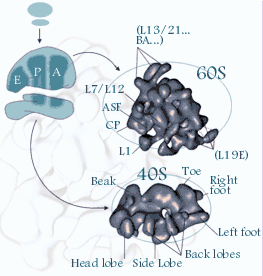 |
The Ribosome
Ribosomes are the actual site
for protein synthesis in all types of cells. Here,
mRNA and aminoacyl-tRNA meet
during translation of the genetic message. In
addition to providing the structural framework for
the decoding process, the ribosome itself contains
the catalytic centre responsible for formation of the
peptide bond, the
so-called
peptidyl
transferase centre.
The ribosomes were first discovered in the early
1940s but their role in protein synthesis first
became apparent more than a decade later. The name
"ribosome" was given to the particles in 1958.
Ribosomes from different types of cells have the same
basic structure but vary in size. Thus, all ribosomes
are composed of two subunits. Each subunit contains a
characteristic set of rRNA (ribosomal RNA) and
ribosomal proteins. In the case of the eukaryotic
ribosome, the two subunits are called the 40S
(Svedberg unit) and
the 60S subunits. The 40S subunit contains one rRNA
molecule, 18S rRNA, and around 35 proteins, while the
60S subunit contains three rRNA species, 5S, 5.8S and
28S rRNA, and approximately 45 proteins.
Together, the two subunits make up the complete 80S
ribosome. The interface region between the two
subunits provides the active surface at which mRNA
and aminoacyl-tRNA interact.
|
